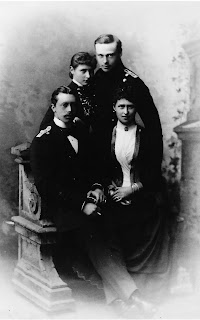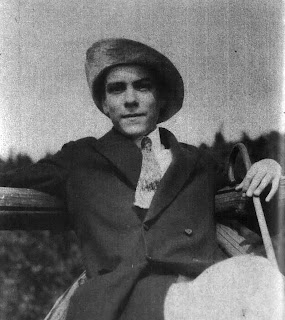Esta tarde (16-17 de julio) llegamos al fatídico centenario del martirio de la Familia Imperial Rusa.
En la tarde del 16 al 17 de julio de 1918, el zar Nicolás II, la emperatriz Alejandra Feodorovna, la gran duquesa Olga Nicholaevna, la gran duquesa Tatiana Nicholaevna, la gran duquesa María Nicholaevna, la gran duquesa Anastasia Nicholaevna y el zarévich Alexei Nicholaevich, acompañados por cuatro sirvientes leales, fueron asesinados por Yakov Yurovski y su grupo en el sótano de la Casa Ipatiev en Ekaterimburgo, la ciudad más bolchevique de la Rusia post-zarista.
La familia imperial estuvo bajo diversas formas de arresto domiciliario durante casi 17 meses, a partir de la abdicación del zar Nicolás II. Este encarcelamiento los llevó desde el Palacio de Alejandro en Tsarskoe Selo hasta la Mansión del Gobernador en Tobolsk, para terminar en la lúgubre prisión en la que se convirtió la Casa Ipatiev.
En ocasiones, la familia imperial era tratada con respeto y deferencia. El contacto con el mundo exterior era esporádico. Los visitantes eran escasos y espaciados. Los miembros de la antigua dinastía gobernante eran mantenidos a raya. Algunos mensajes conseguían llegar a ellos, algunas respuestas conseguían salir. Fueron casi 17 meses de dificultades para el zar y su séquito. Llegaron a Tobolsk con un séquito de casi 40 empleados. Cuando Yurovsky selló su destino, solo quedaban cuatro servidores leales. También serían martirizados en ese pequeño sótano de Ekaterimburgo.
El zar Nicolás y otras diez víctimas sufrieron un final desgarrador a manos de sus carceleros. Las ráfagas de balas se sucedían en oleadas mortales. El humo llenaba la habitación. El hedor de la pólvora, la sangre y la carne... la presencia de la muerte era abrumadora. Aquellos que no murieron a causa de las balas, fueron apuñalados y golpeados con las culatas de los fusiles. Fue un frenesí de brutalidad; una cruel culminación de un acto atroz.
Los cuerpos fueron desechados esa misma mañana. Su paradero permaneció desconocido durante más de seis décadas. Cuando finalmente se encontraron, el lugar se mantuvo en secreto por temor a las represalias soviéticas.
In death, Tsar Nicholas II and his legacy were vilified, as was the entire tsarist period. Was he an effective ruler? That is a question over which entire books have been written. As a political leader, Nicholas II left much to be desired. yet, he was a product of his environment. As a husband, although loving, devoted, and loyal, he allowed his love for his wife to cloud his better judgement. As a father, Nicholas II seems to have excelled. His children were devoted to him, just as he was devoted to them. As Head of House Russia, Nicholas II failed. Many have criticized other Romanovs for seeking to save themselves from the revolutionary tsunami that engulfed Mother Russia. Yet, as Head of House, Nicholas II forgot that he was responsible for the survival of his dynasty. He isolated himself from other Romanovs. He caused an unbridgeable rift within the dynasty. He ignored their warnings. He led the Romanovs into an abyss of death, poverty and exile.
And yet, Nicholas II did not deserve to die in the manner that Yurovsky and his minions secured his horrific ending. His wife, their children, and those four loyal servants, did not deserve to meet the death that was reserved for them.
Let us not forget as we observe this dreadful centennial that many other members of the dynasty met equally harrowing deaths.
The night after the murders in Yekaterinburg, six other Romanovs met a brutal end in a forest outside there town of Alapaievsk. This second group of martyrs included: Grand Duchess Elisabeth Feodorovna, Grand Duke Sergei Mikhailovich, Prince Ioann Konstantinovich, Prince Konstantin Konstantinovich, Prince Igor Konstantinovich, and Prince Vladimir Pavlovich Paley, as well as Sister Barbara, Elisabeth Feodorovna’s faithful companion. Their end was just as vicious as that met by the Yekaterinburg martyrs.
Nearly a month before the ghastly events of Yekaterinburg, Grand Duke Michael Nicholaevich and his faithful secretary were brutally assassinated outside Perm.
And yet, the Bolshevik butchery was not at an end…
In January 1919, four other Grand Dukes were executed inside the walls of the Peter and Paul Fortress: Paul Alexandrovich, Dimitri Konstantinovich, Nicholas Mikhailovich, and George Mikhailovich.
Today, as we remember the victims of Yekaterinburg, Alapaievsk, Perm, and Petrograd, we must be reminded that violence begets violence. Imperial Russia, as difficult as it was for many, does not compare in the brutality and reign of terror that ensued. Modern Russia deserves better than what it has…for the reign of Putin is far worse than the Romanovs ever inflicted on their subjects.
May They Rest in Peace …
































No comments:
Post a Comment